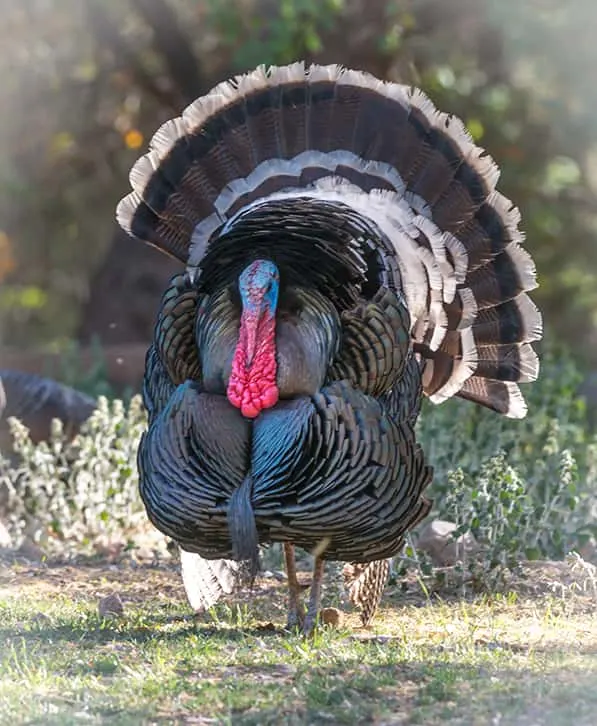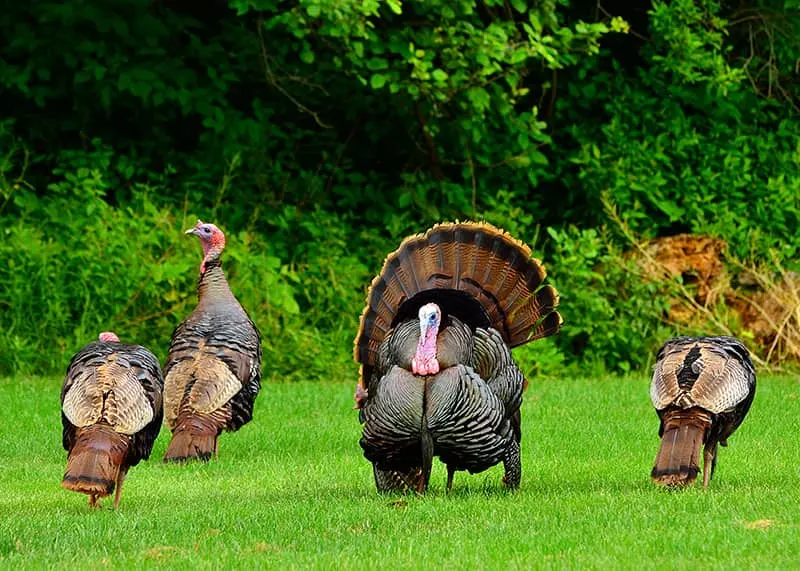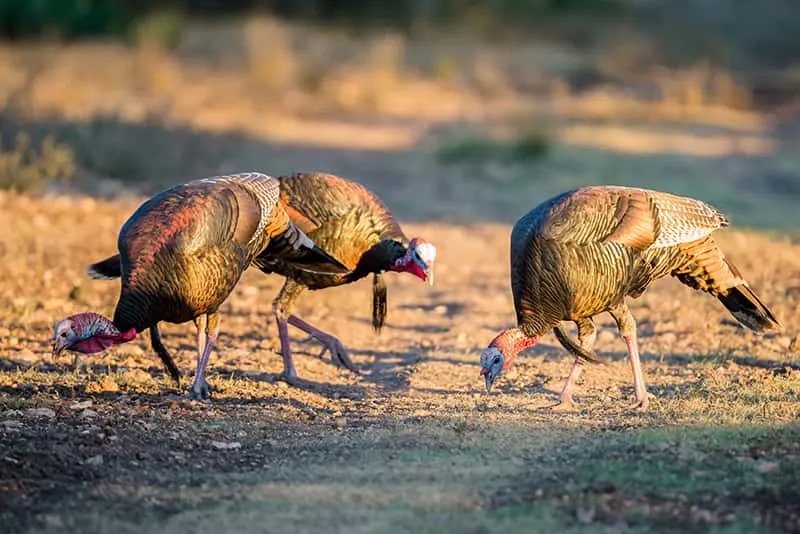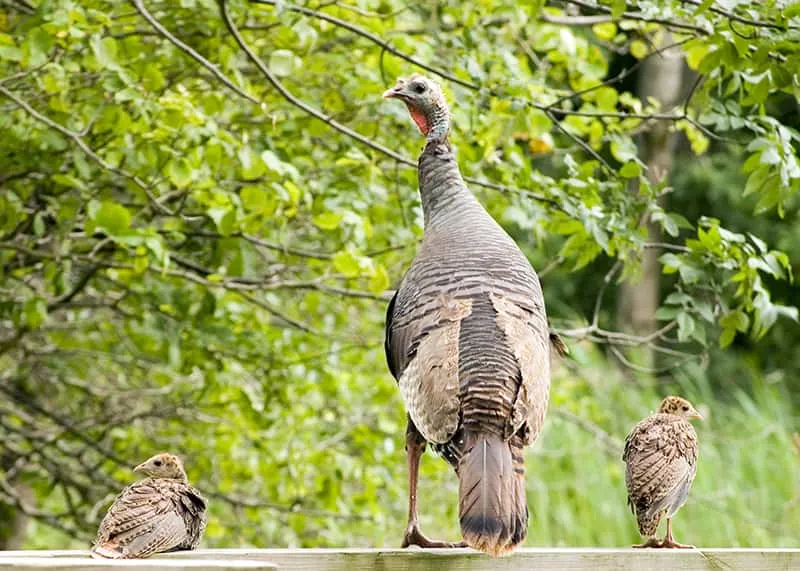Want to learn some turkey facts for kids? You’ll find them in this post. We’ll talk about their physical description, diet, offspring, and more!

Wild turkeys and domestic turkeys are very different. There are two species of wild turkey and five subspecies. We will be discussing the wild turkeys of North America.
Physical Description
Turkeys have small oval-shaped white featherless heads, brown eyes, and yellow beaks. A male turkey’s head can also be blue or red, depending on his mood. Turkeys have long, slim necks that vary in color from red to blue to grey. Turkeys have plump, round, feathered bodies with long legs. Each of their two feet has four toes.
Turkeys have patterned feathers of black, tan, and white. Female turkeys have long tails that hang down. Male turkeys have erected, fan-shaped tails. Their tails are typically reddish-brown with a thick black band and a thin, light brown band on top.
Wild turkeys have red fleshy areas that hang under their chins and above their beaks. These can be a variety of colors, from white to red to purple.
The feathers of male turkeys are more iridescent than those of females. Male turkeys are also bigger than female turkeys. Male turkeys typically weigh up to twenty-four pounds and grow to about four feet in length. Female turkeys typically weigh up to twelve pounds and are about three feet in length.
Habitat
Wild turkeys are found throughout the United States, northern Mexico, and southern Canada. The states of California, Texas, Illinois, Minnesota, and Washington are the states with the highest turkey population.
Wild turkeys mostly live in wooded areas. Their preferred habitat is forests that have pine, elm, and oak trees. Turkeys also live in grasslands, meadows, and urban areas.
Habits
Turkeys live together in flocks. Flocks can be made up of hens and their chicks, or mixed males and females. Turkeys also have flocks that are one male with many females. Flocks can have up to fifty members.

Wild turkeys travel by walking instead of flying. They travel between one and two miles a day across their home range, searching the ground for food. A flock's home range is roughly between three hundred and fifty acres and thirteen hundred acres, depending on flock size.
Wild turkeys are most active in the morning and early afternoon. They spend their time foraging for food, resting, and grooming. They spend a lot of time grooming by taking dust baths, preening their feathers, and sunning.
At night, wild turkeys fly up and roost in trees to sleep. They typically roost together in a different group of trees every night.
Diet
Wild turkeys are omnivores. Their diet includes nuts, fruits, plants, worms, insects, and small reptiles. They also eat sand and gravel to help them digest their food. Wild turkeys get water from their food, but they also drink water from puddles, ponds, and streams.

Offspring
Female wild turkeys lay one clutch of eggs per year. She creates a ground nest space by removing debris with her feet. Nests are built in leaf piles, brush piles, shrubbery, and fields. A turkey hen typically lays ten to fourteen eggs in a clutch. She sits on the eggs every day for about a month until the eggs hatch.
Baby turkeys are born with brown and tan feathers and open eyes. They can walk within a few hours of hatching. They leave the nest and start foraging for food within a couple of days. Baby turkeys can fly and roost in trees by the time they are two weeks old.
Baby turkeys stay with their mothers all the time for the first four months. The mother and her offspring join a flock of moms with offspring as the baby grows into a juvenile.
Male turkeys become adults at seven months old. Females mature slower and become adults at one to two years old.

Classification/Taxonomy
Kingdom: Animalia
Phylum: Chordata
Class: Aves
Order: Galliformes
Family: Phasianidae
Genus: Meleagris
History
The ancestors of the wild turkey evolved about a hundred million years ago, when dinosaurs roamed the earth. Wild turkeys in North America evolved over twenty million years ago.
Predators
Wild turkeys have many natural predators. Mountain lions, coyotes, racoons, eagles, and owls are all main predators of wild turkeys. There are also nest predators that prey on the eggs of wild turkeys. These include foxes, skunks, and snakes.
Lifespan
Wild turkeys typically live three to five years in the wild. Wild turkeys can live up to twelve years in captivity. Female turkeys live longer than males.

What Sound Does a Wild Turkey Make?
Click on this audio file to hear what a wild turkey sounds like.
25+ Facts about Turkeys
- You can tell a turkey's age and gender by its poop!
- The largest wild turkey weighed 37 pounds.
- Domestic turkeys are typically white, but they sometimes look like wild turkeys.
- Wild turkeys don't migrate.
- Male turkeys are called “Toms”, females are called “hens”, and babies are called “poults”.
- A flock of turkeys is called “a rafter” or “a gobble”.
- Alaska is the only state that doesn't have wild turkeys.
- In the 1900s, the National Wildlife Turkey Federation helped bring back the endangered wild turkey population.
- Besides a gobble, turkeys have 27 different calls they make.
- Turkeys can't see well at night, so they sleep when it’s dark.
- Turkeys do not drown if they look up in the rain for a long time. That is a myth.
- A turkey hen lays one egg a day until her clutch of eggs is finished.
- Turkey eggs are white with brown specks and are bigger than chicken eggs.
- Only male turkeys “gobble”, because a “gobble” is a type of mating call.
- The most common wild turkey is the Eastern wild turkey.
- The scientific name of the North American wild turkey is Meleagris gallopavo.
- The species name of the Ocellated turkey is Meleagris ocellata.
- A wild turkey loses its feathers through molting five times before it becomes an adult.
- Benjamin Franklin thought the turkey should be America's national bird instead of the bald eagle.
- Turkeys are strong flyers and can fly up to 50 miles per hour for short distances.
- There are about 7 million turkeys in the US.
- Wild turkeys are not an endangered species and are listed as “Least Concern” on the IUCN Red List.
- 95% of the turkeys eaten on Thanksgiving are domestic turkeys, not wild turkeys.
- The color of a male turkey's head and neck changes depending on his mood.
- Wild male turkeys puff up their feathers to show off.
- The flesh that hangs from a wild turkey's chin is called a “wattle.”
- The flesh that is above a wild turkey's beak is called a “snood.”
We hope you enjoyed learning all about turkeys! Did you learn anything new? Let us know any other facts you know about them. We can’t wait to hear more!
You don't want to miss learning about these cool birds.
